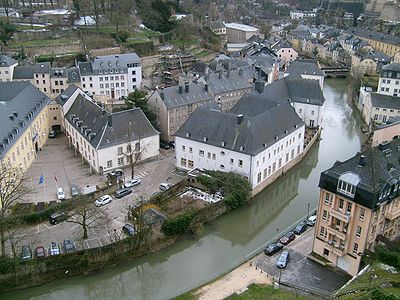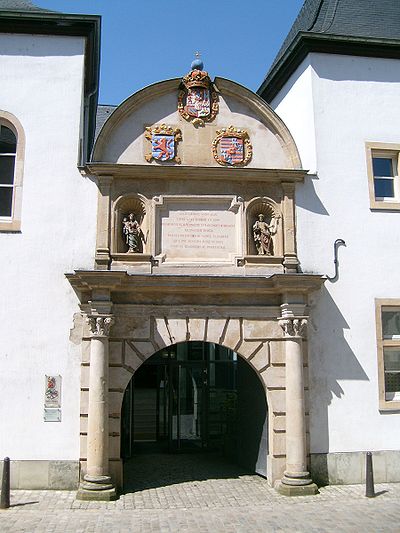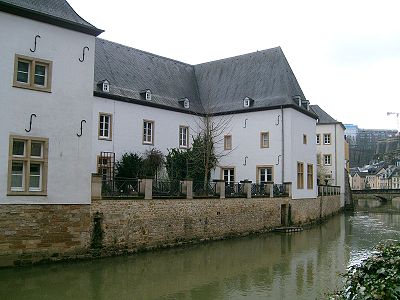
National Museum of Natural History (Luxembourg)
Encyclopedia



Natural History Museum
The Natural History Museum is one of three large museums on Exhibition Road, South Kensington, London, England . Its main frontage is on Cromwell Road...
in Luxembourg City, in southern Luxembourg
Luxembourg
Luxembourg , officially the Grand Duchy of Luxembourg , is a landlocked country in western Europe, bordered by Belgium, France, and Germany. It has two principal regions: the Oesling in the North as part of the Ardennes massif, and the Gutland in the south...
. The museum is located in the Grund
Grund, Luxembourg
Grund is a quarter in central Luxembourg City, in southern Luxembourg. It is located in the valley below the centre of Luxembourg City on the banks of the Alzette River and, in addition to being a picturesque area, is a popular nightlife precinct which can be accessed by foot or via a lift which...
quarter
Quarters of Luxembourg City
The Quarters of Luxembourg City are the smallest administrative division for local government in Luxembourg City, the capital and largest city in the Grand Duchy of Luxembourg....
on the eastern bank of the Alzette
Alzette
The Alzette is a river with a length of 73 kilometers in France and Luxembourg. It is a right tributary of the Sauer.It rises in Thil near the town Villerupt in the Meurthe-et-Moselle département, France. It crosses the border with Luxembourg after a few kilometres. In Lameschmillen it is joined...
river, next to the Neumünster Abbey
Neumünster Abbey
Neumünster Abbey is a public meeting place and cultural centre, located in the Grund district of Luxembourg City in southern Luxembourg. After the original Benedictine Abbey on the Altmünster Plateau had been destroyed in 1542, the monks built a new abbey or Neumünster in 1606 in the Grund...
cultural centre.
The museum is composed of eight separate scientific sections, spanning the natural science
Natural science
The natural sciences are branches of science that seek to elucidate the rules that govern the natural world by using empirical and scientific methods...
s: botany
Botany
Botany, plant science, or plant biology is a branch of biology that involves the scientific study of plant life. Traditionally, botany also included the study of fungi, algae and viruses...
, ecology
Ecology
Ecology is the scientific study of the relations that living organisms have with respect to each other and their natural environment. Variables of interest to ecologists include the composition, distribution, amount , number, and changing states of organisms within and among ecosystems...
, geology
Geology
Geology is the science comprising the study of solid Earth, the rocks of which it is composed, and the processes by which it evolves. Geology gives insight into the history of the Earth, as it provides the primary evidence for plate tectonics, the evolutionary history of life, and past climates...
and mineralogy
Mineralogy
Mineralogy is the study of chemistry, crystal structure, and physical properties of minerals. Specific studies within mineralogy include the processes of mineral origin and formation, classification of minerals, their geographical distribution, as well as their utilization.-History:Early writing...
, geophysics
Geophysics
Geophysics is the physics of the Earth and its environment in space; also the study of the Earth using quantitative physical methods. The term geophysics sometimes refers only to the geological applications: Earth's shape; its gravitational and magnetic fields; its internal structure and...
and astrophysics
Astrophysics
Astrophysics is the branch of astronomy that deals with the physics of the universe, including the physical properties of celestial objects, as well as their interactions and behavior...
, palaeontology
Paleontology
Paleontology "old, ancient", ὄν, ὀντ- "being, creature", and λόγος "speech, thought") is the study of prehistoric life. It includes the study of fossils to determine organisms' evolution and interactions with each other and their environments...
, vertebrate
Vertebrate
Vertebrates are animals that are members of the subphylum Vertebrata . Vertebrates are the largest group of chordates, with currently about 58,000 species described. Vertebrates include the jawless fishes, bony fishes, sharks and rays, amphibians, reptiles, mammals, and birds...
zoology
Zoology
Zoology |zoölogy]]), is the branch of biology that relates to the animal kingdom, including the structure, embryology, evolution, classification, habits, and distribution of all animals, both living and extinct...
, and invertebrate
Invertebrate
An invertebrate is an animal without a backbone. The group includes 97% of all animal species – all animals except those in the chordate subphylum Vertebrata .Invertebrates form a paraphyletic group...
zoology.
History
The Society of the Natural Sciences was established in 1850, under the patronage of Prince Henry, the newly-appointed Governor of Luxembourg representing Grand DukeGrand Duke of Luxembourg
The Grand Duke of Luxembourg is the sovereign monarch and head of state of Luxembourg. Luxembourg has been a grand duchy since 15 March 1815, when it was elevated from a duchy when placed in personal union with the United Kingdom of the Netherlands...
William III
William III of the Netherlands
William III was from 1849 King of the Netherlands and Grand Duke of Luxembourg until his death and the Duke of Limburg until the abolition of the Duchy in 1866.-Early life:William was born in Brussels as son of William II of the Netherlands and...
. The society's primary aim was the promotion of the natural sciences and natural history
Natural history
Natural history is the scientific research of plants or animals, leaning more towards observational rather than experimental methods of study, and encompasses more research published in magazines than in academic journals. Grouped among the natural sciences, natural history is the systematic study...
to the general population. To achieve this, the government put at the society's disposal a section of the city Athenaeum, now the National Library. Opening its doors in 1854, this area hosted a number of cabinets displaying fossil
Fossil
Fossils are the preserved remains or traces of animals , plants, and other organisms from the remote past...
specimens, spread across three rooms. After almost four decades of this arrangement, pressure for display area caused the museum to move into its own premises, at the Vauban Barracks in Pfaffenthal
Pfaffenthal
Pfaffenthal is a quarter in central Luxembourg City, in southern Luxembourg.In 2001, the quarter had a population of 1,208 people....
, in 1892. However, these were criticised for being unattractive to visitors, hence undermining the museum's attempts to promote natural history to the general public.
In 1922, the museum moved once again. The new site was the Old Gendarmerie, on the Fishmarket
Fishmarket
Fishmarket , also spelt Fish Market, is a street in Luxembourg City, in southern Luxembourg, that shares its name with the neighbourhood directly surrounding it. It lies in the eastern part of the Ville Haute quarter....
, in the historic heart of Luxembourg City, which the museum shared with the National Museum of History and Art
National Museum of History and Art
The National Museum of History and Art , abbreviated to MNHA, is a museum located in Luxembourg City, in southern Luxembourg. It is dedicated to displaying artworks and artefacts from all epochs of Luxembourgian history...
. Purchased by the government, the building, along with a neighbouring house, were initially unsuitable for the housing of the museum, and the state embarked upon a renovation programme, during which time, the collections were closed to the general public, causing much public anger. The renovations had almost been completed by the outbreak of the Second World War
World War II
World War II, or the Second World War , was a global conflict lasting from 1939 to 1945, involving most of the world's nations—including all of the great powers—eventually forming two opposing military alliances: the Allies and the Axis...
, but the German occupation
German occupation of Luxembourg in World War II
The German occupation of Luxembourg in World War II was the period in the history of Luxembourg after it was used as a transit territory to attack France by outflanking the Maginot Line. Plans for the attack had been prepared by 9 October 1939, but execution was postponed several times...
caused the museum to move again temporarily to protect its collections. Despite the war, the building in Fishmarket was virtually undamaged, allowing the museum to re-occupy the premises immediately. In 1946, a temporary installation was opened, marking the museum's return to its original purpose, thirty-four years after its closure. By 1952, the last room had been opened, marking a return to normal operation.
It was in the decades following the war that the museum diversified away from its core activities, engaging in fields such as geophysics
Geophysics
Geophysics is the physics of the Earth and its environment in space; also the study of the Earth using quantitative physical methods. The term geophysics sometimes refers only to the geological applications: Earth's shape; its gravitational and magnetic fields; its internal structure and...
and astrophysics
Astrophysics
Astrophysics is the branch of astronomy that deals with the physics of the universe, including the physical properties of celestial objects, as well as their interactions and behavior...
; such was the museum's commitment to these fields that it was the owner of the first electron microscope
Electron microscope
An electron microscope is a type of microscope that uses a beam of electrons to illuminate the specimen and produce a magnified image. Electron microscopes have a greater resolving power than a light-powered optical microscope, because electrons have wavelengths about 100,000 times shorter than...
in the country. However, the expansion of the museum into these additional fields put added pressure on the space of the museum in Fishmarket, particularly as the National Museum of History and Art was also expanding. After a decade-long search for a suitable new site, on 11 January 1990, the Chamber of Deputies
Chamber of Deputies of Luxembourg
The Chamber of Deputies , abbreviated to the Chamber, is the unicameral national legislature of Luxembourg. 'Krautmaart' is sometimes used as a metonym for the Chamber, after the square on which the Hôtel de la Chambre is located....
agreed to restore Saint Jean's Hospice, in Grund
Grund, Luxembourg
Grund is a quarter in central Luxembourg City, in southern Luxembourg. It is located in the valley below the centre of Luxembourg City on the banks of the Alzette River and, in addition to being a picturesque area, is a popular nightlife precinct which can be accessed by foot or via a lift which...
.
The new site was opened in June 1996, spread across three buildings, each dedicated to a different aspect of the museum's functions: collection displays, teaching classrooms, and research laboratories.

